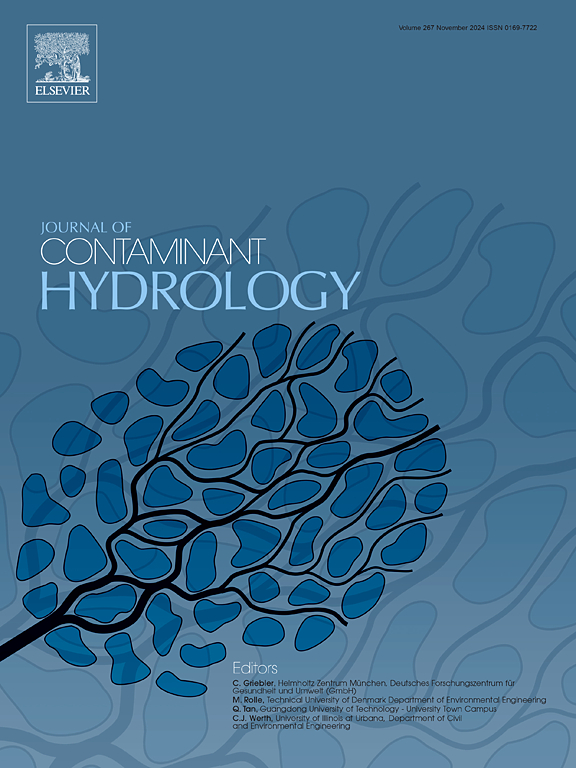解释硝酸盐浓度空间变化的土地利用回归模型——爱尔兰西北部的区域尺度案例研究
IF 3.5
3区 环境科学与生态学
Q2 ENVIRONMENTAL SCIENCES
引用次数: 0
摘要
区域尺度的地下水污染评估对水资源的可持续管理至关重要。评价地下水的主要障碍包括可用数据有限、样本量小以及难以将浓度水平与土地利用模式联系起来。线性回归确定了测量浓度与自然和人为影响因素之间的关系。然而,该方法的主要困难在于,当存在多个潜在回归量时,如何选择一组满足模型所有必要条件的回归量。本研究引入基于缓冲区的土地利用线性回归方法,建立流域尺度的地下水硝酸盐浓度预测模型。该模型成功捕获了整个研究区域85%的硝酸盐空间变异性,来自32个训练地点的验证结果表明。在模型开发阶段(R2 = 0.89)和验证阶段(R2 = 0.80),发现模型的预测能力和捕获硝酸盐浓度空间变异性的能力较好。该模型在精度评估和误差估计过程中表现良好(RMSE = 0.025, MAE = 0.020)。未来,该LUR模式可以用最新可用的时间序列数据集重新参数化,以捕捉气候变化情景。虽然这项研究的重点是博内河的一个小集水区,但该方法有可能应用于边界研究区。未来的研究将采用更稳健的方法和更准确的预测变量来解释污染源、输送和衰减过程的影响,从而改进基于缓冲区的LUR技术,使其具有更好的模型适应性和对其他研究领域的适用性。本文章由计算机程序翻译,如有差异,请以英文原文为准。
A land use regression model to explain the spatial variation of nitrate concentration – A regional scale case study in the north-west of Ireland
Regional-scale groundwater contamination estimation is crucial for sustainable water management. The primary obstacles in evaluating groundwater include limited data availability, small sample sizes, and difficulties in linking concentration levels to land use patterns. Linear regression identifies the relationship between measured concentrations and both natural and human-influenced factors. However, the primary difficulty with this method lies in choosing a group of regressors that meet all necessary criteria for the model when multiple potential regressors exist. This study introduces a buffer-based land-use linear regression method to develop a catchment-scale model for predicting nitrate concentrations in groundwater. The model successfully captures 85 % of the spatial variability in nitrate across the study area, as indicated by the validation results from 32 training sites. The model's prediction capability and ability to capture the spatial variability of nitrate concentration were found to be good in the model development (R2 = 0.89) and validation (R2 = 0.80) steps. The model performed well in the accuracy assessment and error estimation processes (RMSE = 0.025 and MAE = 0.020). In future, this LUR model can be reparameterised with the latest available time series datasets to capture climate change scenarios. While this study focused on a small sub-catchment of the Bonet River, the methodology has the potential to be applied in a border study area. Future studies with a more robust methodology and more accurate predictor variables to explain the influence of the contamination sources, transport and attenuation processes can improve the buffer-based LUR technique for better model adaptation and applicability to other study areas.
求助全文
通过发布文献求助,成功后即可免费获取论文全文。
去求助
来源期刊

Journal of contaminant hydrology
环境科学-地球科学综合
CiteScore
6.80
自引率
2.80%
发文量
129
审稿时长
68 days
期刊介绍:
The Journal of Contaminant Hydrology is an international journal publishing scientific articles pertaining to the contamination of subsurface water resources. Emphasis is placed on investigations of the physical, chemical, and biological processes influencing the behavior and fate of organic and inorganic contaminants in the unsaturated (vadose) and saturated (groundwater) zones, as well as at groundwater-surface water interfaces. The ecological impacts of contaminants transported both from and to aquifers are of interest. Articles on contamination of surface water only, without a link to groundwater, are out of the scope. Broad latitude is allowed in identifying contaminants of interest, and include legacy and emerging pollutants, nutrients, nanoparticles, pathogenic microorganisms (e.g., bacteria, viruses, protozoa), microplastics, and various constituents associated with energy production (e.g., methane, carbon dioxide, hydrogen sulfide).
The journal''s scope embraces a wide range of topics including: experimental investigations of contaminant sorption, diffusion, transformation, volatilization and transport in the surface and subsurface; characterization of soil and aquifer properties only as they influence contaminant behavior; development and testing of mathematical models of contaminant behaviour; innovative techniques for restoration of contaminated sites; development of new tools or techniques for monitoring the extent of soil and groundwater contamination; transformation of contaminants in the hyporheic zone; effects of contaminants traversing the hyporheic zone on surface water and groundwater ecosystems; subsurface carbon sequestration and/or turnover; and migration of fluids associated with energy production into groundwater.
 求助内容:
求助内容: 应助结果提醒方式:
应助结果提醒方式:


